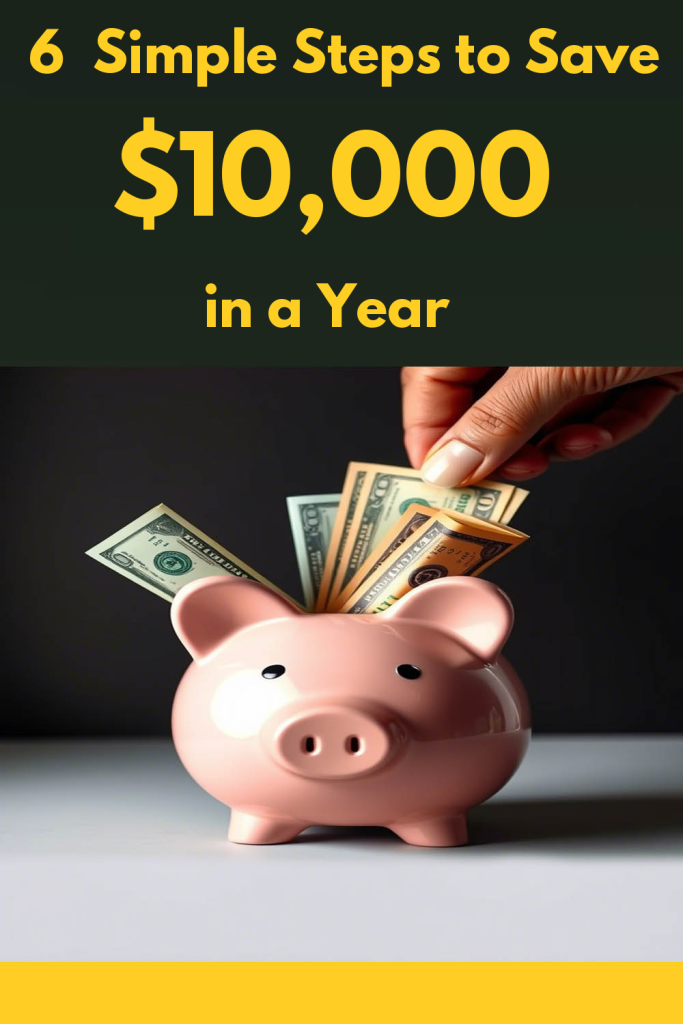6 Simple Steps to Save $10,000 in a Year
A year ago, the thought of saving $10,000 seemed impossible.
I was living paycheck to paycheck, spending money on things I didn’t even use, and convincing myself that “saving” meant giving up all the fun in life.
It wasn’t until my car broke down and hit me with a $1,200 repair bill that I realized how unprepared I was.
I had just $87 in my savings account.
That was my wake-up call.
I knew I had to make a serious change, so I created a plan.
It wasn’t always easy, but by following six key steps, I managed to hit my $10,000 goal in just one year.
If you’ve ever felt like saving money is too overwhelming, trust me—I was in the same boat.
But breaking it down into simple actions made all the difference.
Here’s exactly how I did it, and how you can too.

1.) Breaking Down the Goal
When I first set the $10,000 savings goal, it felt like an enormous mountain to climb.
But I quickly realized that the key was to break it into smaller, manageable steps:
- $10,000 a year = $833 a month
- $833 a month = $192 a week
- $192 a week = $28 a day
Seeing the numbers this way made it feel achievable.
Instead of stressing over a huge sum, I focused on saving $28 a day.
That was something I could work with.
To keep myself motivated, I printed those numbers and stuck them on my fridge.
Every morning, I’d see them while making breakfast, reminding me of my goal.
I also used You Need A Budget (YNAB) to track my expenses, which quickly exposed my unnecessary spending.
For example, my daily Starbucks habit cost me $28 a week—the exact amount I needed to save daily.
That realization alone was a game-changer.
2.) Cutting Unnecessary Expenses
Once I knew my daily savings target, I took a hard look at my expenses.
I was shocked by how much I was wasting on things I didn’t even use.
Subscriptions were my first target.
I was paying $45 a month for three gym memberships—despite not stepping foot in a gym for over a year.
I also had multiple streaming services that I barely watched.
Cutting these saved me:
- $32/month by canceling four streaming services
- $25/month by switching to a cheaper phone plan
- $150/month by brewing coffee at home instead of buying it daily
The biggest game-changer was meal prepping.
I used to spend $15 on takeout lunches multiple times a week without thinking twice.
Once I started cooking my own meals, I saved $300 a month—and I actually enjoyed the process.
3.) Turning Clutter Into Cash
One of the fastest ways I boosted my savings was by selling things I didn’t need.
My closet was filled with impulse buys, and my garage was home to abandoned hobbies.
Instead of letting them collect dust, I turned them into money:
- Sold an old camera on eBay: $420
- Sold designer jeans on Poshmark: $200
- Sold my unused Peloton: $1,100
In total, I made $1,720 just from decluttering my home.
Not only did it feel good to clear out space, but it also made me rethink my spending habits.
Every time I wanted to buy something new, I asked myself, “Will this just end up as another thing to sell later?”
That mindset shift helped me cut back on impulse shopping.
4.) Earning Extra Money Without Burning Out
I didn’t want to take on a second full-time job, so I found small, flexible ways to earn extra income:
- Dog walking (via Rover): $120 a week
- Freelance writing for local businesses: $200 per article
- Weekend shifts at a café: $150 a week
These small side hustles added up to about $800 a month—nearly covering my savings goal on their own.
Some weeks were tiring, but the motivation of watching my savings account grow kept me going.
5.) Automating My Savings
To avoid the temptation of spending my extra money, I automated my savings.
Every payday, I set up an automatic transfer of $200 into a high-yield savings account.
That way, I never even saw the money in my checking account—it was gone before I could be tempted to spend it.
I also used Acorns, an app that rounds up my purchases and saves the spare change.
At first, I didn’t think those tiny amounts would matter, but after a few months, I realized I had saved $43 a month just from spare change.
A big win came when I got a $1,200 tax refund.
Instead of using it for a shopping spree, I acted like it didn’t exist and transferred it straight to my savings.
Step 6: Negotiating My Expenses
One of the most surprising ways I saved money was by negotiating bills.
I used to assume that monthly expenses were fixed, but once I started making phone calls, I realized how much I could lower them.
- Negotiated my internet bill: saved $120/month
- Switched car insurance providers: saved $65/month
- Moved to a smaller apartment: saved $200/month
Total savings from negotiations: $4,620 a year—just from a few phone calls.
It was a reminder that sometimes, the easiest way to save money is simply asking for a better deal.
The Darkest Moment (And How I Survived)
By month six, I had saved $5,000.
I was feeling confident—until my laptop died.
The old me would’ve dipped into my savings without thinking twice.
Instead, I problem-solved:
- Bought a refurbished MacBook for $600 instead of a new one for $1,300
- Used my side hustle earnings to cover half the cost
- Celebrated my smart choice with a budget-friendly picnic in the park
This moment was proof that I had changed my habits.
Instead of panicking, I found a way to stay on track.
The Final Result
On December 31st, I checked my savings account: $10,327.
I couldn’t believe it.
I had actually done it.
I even shed a few happy tears before doing a victory dance in my pajamas.
What worked?
- Small daily changes (coffee, meal prepping) built discipline
- Side hustles and selling stuff brought in big savings boosts
- Automating my savings made it effortless
- Flexibility helped me adjust when things went wrong
Was It Worth It?
Absolutely.
But not just for the money.
Saving $10,000 wasn’t just about having a bigger bank account—it changed my entire mindset.
Now, I see saving money as buying freedom.
I no longer panic when unexpected expenses come up.
I have options.
And that’s priceless.
Start today:
Pick one step.
Cancel a subscription.
Sell something.
Transfer $20 into savings.
The key isn’t perfection—it’s progress.
And if I can do it?
You can too. 💪
P.S. I still treat myself to Starbucks—just once a month. Balance, people. 😉


